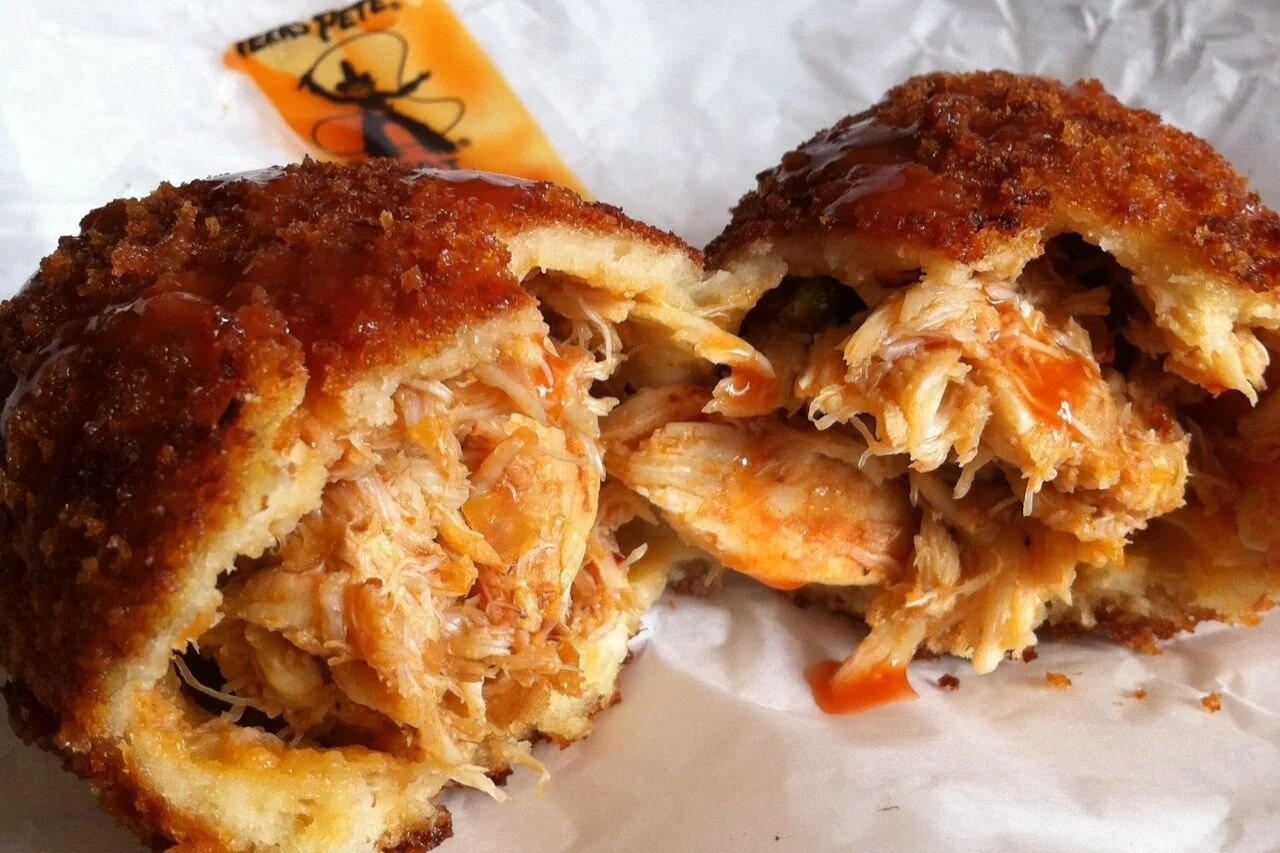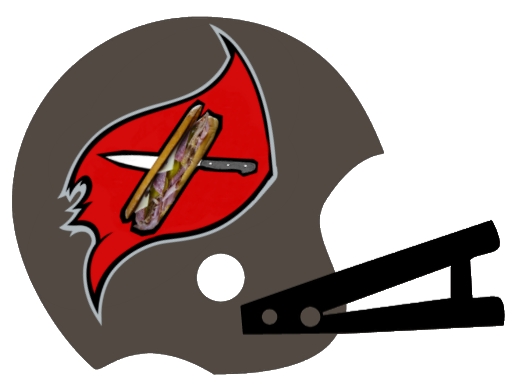"The National Foodball League" Project: Tampa Bay
by Mike “Stabbed by A Crab Claw” Lunsford, Editor-in-Chief of the Great Geek Refuge
After experiencing the wonders of Jacksonville and their delicious, unexpected icon food, I decided to virtually stay in the Sunshine State. After all, Florida does have 3 professional football teams, I might as well stay and finish the whole state while I’m here. Plus, as I was researching the cities in Florida, I ran across some interesting facts and history when it comes to food. So, without further delay let’s jump right in to the 5th most populated region on the East Coast: Tampa Bay.
For distinction purposes, let’s discuss why the city itself is called Tampa, but the professional sports teams go by Tampa Bay. When referring to the entire region of “greater Tampa,” the term used is Tampa Bay, which encompasses a wider area. SO WE’RE CALLING IT ALL TAMPA BAY. GET ON THE BUS!
Now that everyone’s on the bus, let me grab the mic for the loudspeaker and make an announcement. The purpose of this “Foodball League” was a self-indulgent exploration of the famous foods in each city that has a football team and a chance to refine my digital art skills. It started because I wanted a to create a logo for the Washington football team that actually had something to do with the city and was NOT racist. When it comes to Tampa, there is quite a bit of history that colors the culinary landscape of this Gulf community.
History
The Tampa Bay region has had civilizations for thousands of years, but was not an area of interest to the invading Spanish in the 15th and 16th centuries because of the area’s lack of gold and silver. When they did venture into the area, the Tocobaga, Calusa and Pohoy peoples fought them off. Since there was no real invested interest to keep fighting, they left. HOORAY! But they left a present: all those great European diseases! Wait…
When the Brits showed up in the 18th and 19th centuries, there was not a large population of Tocobaga, Calusa or Pohoy people in the Tampa Bay area . Just a whole lot of mass graves… due to the massive die off of Native American populations following European first contact, ya know the thing we talked about in the paragraph above! Or maybe it was the forced relocation and wars against the native Tocobaga, Calusa or Pohoy peoples.* At any rate, the Tampa Bay area was really nothing more than a seasonal fishing town during these times. In fact, the area remained sparsely populated all the way through the Civil War and into the 1880s.
*For more information on the first inhabitants of the Florida, click here
It was in the 1880s that the largest deposit of phosphates in the United States was discovered near Tampa. In conjunction with the South Florida Railroad system coming to Tampa in 1883, these events turned the city into a boom town almost overnight, as phosphates are a key component in fertilizers and other products. Tampa became a distribution hub for the rest of the country. Seeing this as an opportunity to continue the growth of their burgeoning city, the Tampa Trade Board enticed cigar magnate Vicente Martinez Ybor to move his cigar business to the area. In doing so, he brought with him many other cigar manufacturers and eventually they established the neighborhood of Ybor City.
Ybor City was unique in the US, especially the south. It grew to become a very successful town and it was almost entirely populated and owned by immigrants. Not only was it a place owned by and populated by immigrants, many progressive social programs were put into place. The cigar factory employees were well paid and because of that, Tampa took on the nickname "Cigar City" and transformed the city into a bustling metropolitan area. And it wasn’t just Cuban, Spanish and Mexican cigar workers either. Italian and Eastern-European Jewish immigrants came to the area and started shops, restaurants, farms, and more in support of these workers. Because of this, a unique diverse mash-up of cultures and cuisines happened. And with that perfect segue, lets get into the food aspects of the Tampa Bay area.
Food
A common trend that we see when it comes to the cities we’ve discussed, location plays a huge role in the iconic food of the region. I mean…duh, right? You’re close to water, seafood becomes a big part of the diet. That being said, Tampa is known for the fresh seafood pulled from the Gulf of Mexico. Grouper sandwiches are a staple across the state, as it's a plentiful fish that makes a delicious sandwich, either grilled, blackened or fried. And in the Tampa Bay area, finding a good “fish camp” that serves up fresh grouper and other delicacies of the sea is a no-lose situation. There are tons of fish camps and rarely can you go wrong.
The grouper is a noble fish…if there is such a thing. I don’t know, calling it a “noble fish” just sounded like a nice thing to say before I say “nah, there are better choices for a logo.” A fish sandwich seems pretty pedestrian across the board, and especially because it doesn’t have any real significance to Tampa Bay, that’s gonna be a no from me, dawg. Next dish.
I mentioned Ybor City previously as a truly diverse and remarkable place. It was also a place of innovation. Another plentiful seafood creature found in the Gulf of Mexico is the blue crab. Now, don’t any of you go and tell Marylanders that blue crabs are down in the Gulf of Mexico (and in fact, there’s more down there than in the Chesapeake region). Swear to god, they might stab you with a crab claw and throw Old Bay in your wounds. When those Cuban and Spanish immigrants came to Ybor City and started looking for tasty things to eat, they found these pissed off little sea cockroaches and decided to make something tasty out of them. They combined the crab meat with some leftover Cuban bread, some onions, peppers, tomatoes, and spices. What comes out is a tasty, spicier, more hand-held version of the Maryland crab cake that the Spanish speakers call croqueta de jaiba. Americans call it deviled crab and it was invented in good ol’ Ybor City!
I’m about to alienate a lot of my Marylander friends and readers….but this looks tastier than a regular crab cake.
It was hard not to pick the Croquetas as a logo for the Tampa Bay team. They’re cool, they’re tasty, and who doesn’t like fried seafood treats? No one that’s who! Except those who have shellfish allergies…I guess that’s a pretty good reason not to eat deviled crab. I would be very proud of this logo as it is iconic. But once you see this pic I made, you’ll understand why this was a runner up.
Again we return to Ybor City and this awesome neighborhood run and owned by immigrants from all over the world! When all those cigar factory employees needed something delicious to eat, they turned to the cafés that were popping up in support of the workforce. And these cafés used what was readily available for the culturally diverse shops. A sandwich that consisted of sliced, roasted Cuban “mojo style” pork, glazed Spanish ham, Italian salami, swiss cheese, pickles, yellow mustard all on a loaf of Cuban bread became a favorite. It had 2 names: the Spanish-speaking immigrants called it a mixto as it was a mix of meats, the English speaking immigrants called it a “Cuban” because, simply, that’s who they saw eating these amazing sandwiches.
Not only is the sandwich delicious, it’s a perfect icon to represent the beautiful side of what makes America great: people of all cultures coming together. A “Cubano” sandwich is actually an American creation, but like most Americans, it’s roots are a mix of different cultures and influences. That’s the kind of symbol I’d want on my city’s football helmet, and thus we have the next franchise in the National Foodball League. Representing the Gulf coast of Florida, The Tampa Bay Cubanos.
And you know how I am when it comes to retro logos and designs, so I did one with the often maligned creamsicle colors. Here are the links to get a sweet t-shirt in either logo!
Normally, this would be the point in the article where I would start wrapping things up and letting you know about what city I might have in my sites next. I already mentioned I’m staying in Florida, so that leaves me with Miami. But…here’s the thing: the normally fun, happy-go-lucky nature of these articles is about to take a contentious turn. Prepare yourself with this knowledge: even though the Cubano is recognized as being invented in Ybor City in Tampa, Miami has tried to lay claim to this sandwich. With many Cubans escaping the Communist Castro regime settling in Miami, they feel that makes the sandwich a Miami thing, just in name alone. So instead of leaving this a mystery as to what city comes next, I’m giving you a tease: Miami is coming. They are not happy about this mixto disrespect and will state their case for it belonging to them in our next article. And there’s more! Prepare yourself mentally for a Florida classic that is so mysterious, so unknowable that the truth may shock you. So make sure you catch the next installment of “the National Foodball League” Project when travel south, through the mysterious Everglades to Miami.





















Mike returns to the “Foodball League Project” with an entry about the Steel City of Pittsburgh.